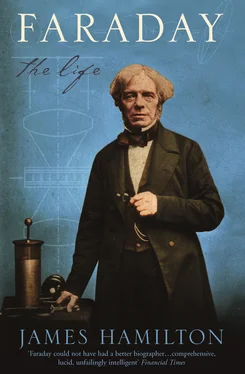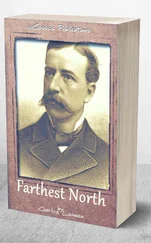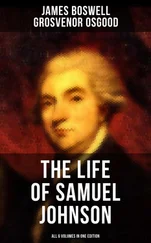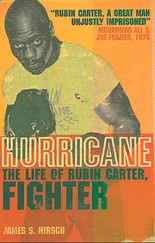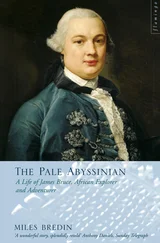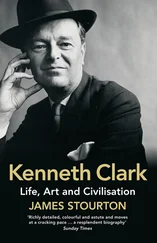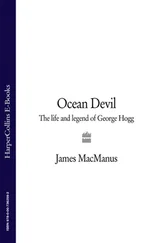Davy and Faraday began by keeping the ammonium solutions as cold as possible by surrounding the basins with ice, but soon they relaxed that operation as they found it slowed the process down. When the chlorine came into contact with the solution, the liquid began to rise dramatically up the jar, and drops of yellow oil rose and then gently dropped down into the liquid to lie as an oily layer at the bottom. They found slightly different rates of absorption between the nitrate and the chloride, but the compound that lurked at the bottom of the retort was more or less the same in both versions of the experiment.
Having formed itself, this compound then began to give off nitrogen very actively. The liquid seethed with a sharp, stinging smell, ‘bringing forth tears in abundance it excites also a very disagreeable sensation in the nostrils and lungs’. When separated from the liquid the compound solidified in a buttery way, and lay pregnant with potential on its dish. This was where the excitement began again. Davy and Faraday put a tiny piece of it into some water and dropped some phosphorus into the basin. Suddenly, bang! – the whole thing exploded, shattering the basin and throwing glass, earthenware, water and the remains of the evil compound up into the air and everywhere. The two men were shocked, but slowly raised their heads above the bench as the clink of precipitated glass fragments died away. They tried once more to tame the beast by reversing the process and adding the compound to the phosphoric solution. This made a sudden flame, but there was no explosion. While they were doing the experiment, Davy blithely reminded his assistant how he had nearly blinded himself the past autumn by trying to heat it up.
Another of Faraday’s jobs that afternoon was to collect the compound together from the various retorts and basins. This he did very gingerly, knowing its explosive power in combination. Davy was not discouraged by the dangers – they seemed to empower him – and this gave confidence to his assistant. Together they set to work again on new ways of attacking the chloride of nitrogen. They tried mixing hydrochloric acid with it in a glass tube, and this caused a rush of gas out of the liquid, filling the tube with bubbles ‘which expanded as they ascended in a beautifull manner to fourteen or fifteen times their original bulk and the tube quickly became full of this gas’. The gas was piped to a trough of water, and its smell and colour immediately revealed it to be chlorine, with a tiny admixture of oxygen. The resulting precipitate was ammonium chlorate. They tried the trick again, this time with nitric acid, and nitrogen alone came off. Then they tried a third time, with a solution of potash. For a fourth time, Davy told Faraday to do it with ammonia, and this immediately produced thick acrid smoke, ammonium chloride, which filled the laboratory, making them both choke violently. Once the smoke had cleared they took some more glass bowls and tubes and tried again with ammonia. The smaller tubes constrained the reaction, but in an instant the whole lot exploded. That brought the experiments to an end, and it was Faraday who had to clear up the mess.
The next day they tried again, this time with yet more violent results. There were four big explosions in the laboratory that day, 58audible throughout the building. Perhaps they caused some alarm, and staff ran downstairs to see what had happened; or perhaps the Royal Institution, being used to the Professor’s stinks and bangs, took little notice. So the Professor and his new boy carried on, undaunted, ducking down behind the bench when they felt the need. They wore glass masks, which were some protection, but the day’s work came to an abrupt end when Faraday had his hand nearly blown apart. The tube he was looking at rather too closely exploded in front of his face, blew violently out of his hand, shattered his mask and took part of his fingernail with it.
Working side by side, the two men were the vanguard, the thin line between the known and the unknown. In his first Elements lecture, Davy stressed the importance of instruments, and the progress that had been made in chemical discovery simply through the development of new, better and yet more ingenious pieces of equipment. ‘Nothing,’ he wrote, ‘tends so much to the advancement of knowledge as the application of a new instrument.’ 59Davy was a gadgets man, perfectly at home with glass tubes, bottles and retorts, ground glass stoppers and brass taps and mounts, jointing them together like infinitely variable skeletal remains, with gutta percha, caoutchouc, string or wax or a combination of some of these, though safety was never taken much notice of.
We know nothing of the talk that went on between Davy and his assistant in the laboratory. Davy, who had recently enlarged and published his Elements of Chemical Philosophy lectures, cannot possibly have been silent about them to his companion as they worked together. In a later remark, Faraday described Davy as ‘a mine inexhaustible of knowledge & improvement’, 60and it is likely that that knowledge and improvement will have emerged, by demonstration and example, from the mine from their first day together. Davy will have shown Faraday the importance and efficacy of accurate and accurately-made instruments. Engravings in the back of the Elements volume suggest that the equipment was neat and precise, but the reality at Davy’s chaotic bench, where instruments might have to be devised on the spot at speed, was rather different. Davy, quick in movement, might carry on several unconnected experiments at the same time, and ‘was perfectly reckless of his apparatus, breaking and destroying a part in order to meet some want of the moment … With Davy, rapidity was power.’ 61
Faraday, who was himself already an expert maker of electrical equipment, was more careful and circumspect, perhaps shocked by Davy’s bullish approach. But he had much to tell Davy about his own experiences with batteries, electrolysis, the making of crystals and so on, and with two such articulate and involved men on common ground the talk cannot have been idle.
The importance of chemistry, its role as a civilising force in world affairs, was a topic that Davy had written about extensively. Chemistry in the early nineteenth century had been shown by Davy to be the key to industrial and economic progress in peace and war. The manufacture of porcelain and glass, dyeing and tanning, advances in medicine and agriculture, improvements in the composition and manufacture of gunpowder, were all dependent on the growth of chemical knowledge, and that, in its turn, depended on the progress that Sir Humphry Davy was personally making in his laboratory in the Royal Institution basement. In his correspondence with Abbott Faraday revealed that his own private experiments were careful and ordered, and followed more or less a course of self-improvement in science. What may once have seemed to Faraday, through Tatum’s lectures and his conversations with friends, to be an involved and complex subject, dissolved through talk with Davy into a perspective of reasoned, reassuring and repeatable processes. Davy saw the simplicity of the subject, the inter-connectedness of chemical laws, and he put this across clearly in his writings:
It is indeed a double source of interest in this science, that whilst it is connected with the grand operations of nature, it is likewise subservient to the common processes as well as the most refined arts of life … Complexity almost always belongs to the early epochs of any science; and the grandest results are usually obtained by the most simple means. 62
In putting the discipline to which he had dedicated his life and health into its place, Davy brought comfort and reassurance to Faraday, quite as much as he imparted knowledge. Working and talking with Davy, Faraday found a structure for his knowledge, and a purpose for acquiring and categorising it. He now had somebody with whom to share his instinctive appreciation of the visual beauty of chemicals – the sheer, relentless black of carbon, the yellow of sulphur, purple of potassium – and their changes in colour, nature, texture, state, even taste if they were bold enough, that took place in reactions in the laboratory. The harmony, novelty and magic of the chemical names that tripped upon the tongue – silicium, aluminium, zirconium, ittrium, glucium, manganese, zinc, tin, iron, lead, antimony, bismuth, tellurium, cobalt, copper, nickel, palladium, uranium, osmium, tungsten, titanium, columbium, cerium, iridium, rhodium, mercury, silver, gold, platina (now ‘platinum’) – all these wonderful names had run in their turn from Davy’s own pen, 63and through the smoke and fume of experiment many must have found their moment in conversation.
Читать дальше
